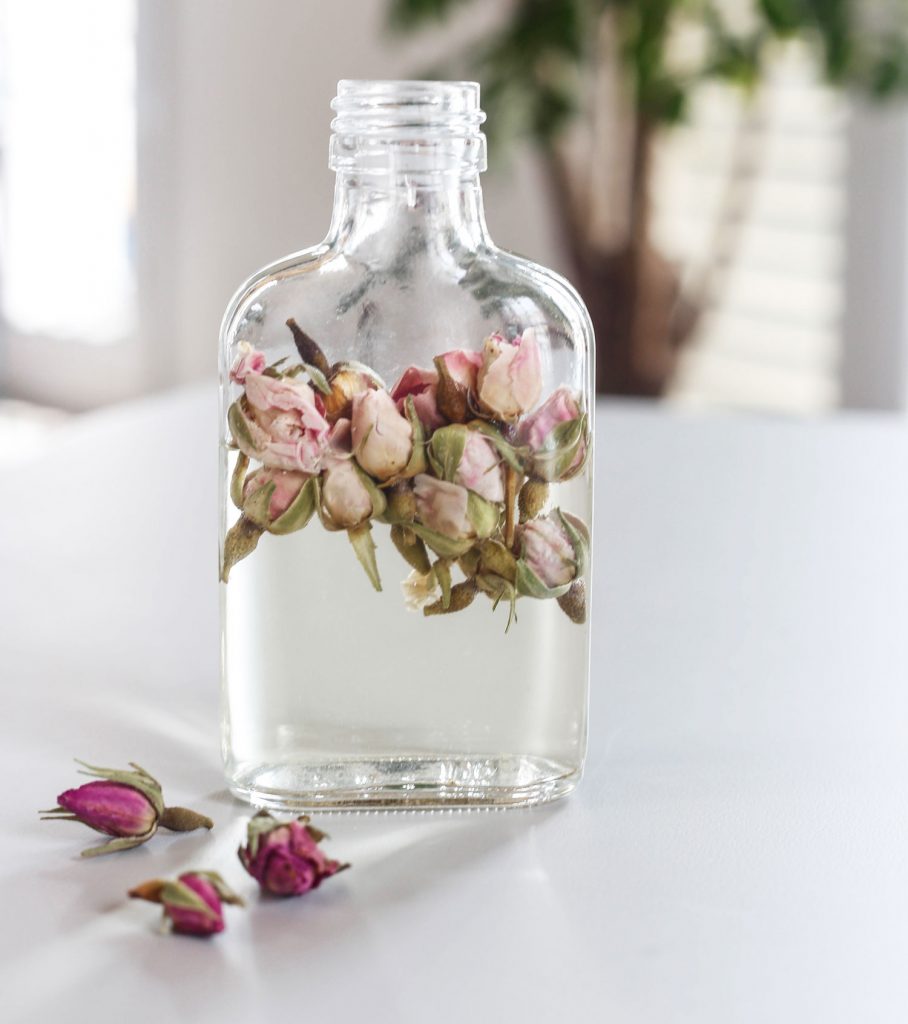
For years, I thought I was using hydrosols in my natural skincare routine – until I experienced the real thing!
Witch hazel has long been a favorite toner of mine (and for the guys too!). It’s amazing for oily skin, humid climates… but I could only ever find the kind with alcohol – which can dry out my skin pretty quickly. Then a few months ago, I came across the natural brand S.W. Basics. Their toner has witch hazel in it, but she talked about how different is – no alcohol, pure. On their website, I noticed they even link to the exact farms that they source the hydrosol from… so I clicked over to check it out.
That opened up a whole new world for me.
I realized that the witch hazel hydrosol I’d been using was nothing like that. These farms talk about wild harvests, sustainable farming, hand-distilling – no alcohol, no added ingredients.
I ended up digging deeper, finding more suppliers. I had to try it for myself and ordered a bottle of pure witch hazel hydrosol.
I was so surprised. It was completely different than what I was used to buying. Pure witch hazel is aromatic, it smells light and fresh. It’s very cleansing, but gentle on the skin.
And it’s not just witch hazel – you can find so many different botanicals with different properties. Hydrosols like cucumber, rose, lavender, ginger….
I reached out to my friend and herbalist Alina from Abundant Earth to learn more about hydrosols – what exactly are they and how do we use them. I’ve also linked below a few sources for you to find really good quality hydrosols and start experiencing the effects on your skin too!
Alina’s Hydrosol Factsheet
WHAT ARE HYDROSOLS?: Hydrosols are the by-product of essential oil distillation. Steam is passed through plant material, and the condensate collected. The essential oil floating on the surface is collected, and the water that remains is the hydrosol. Hydrosols are intensely aromatic, and share some of the healing properties of essential oils.
THE BENEFITS OF HYDROSOLS: Hydrosols are around 30 times stronger than herbal teas, and gentler than essential oils. They can be used for health, skincare, perfumery, and to enhance food and drinks.
HOW TO USE HYDROSOLS: Hydrosols may be used in many ways. It can be as simple as adding a little peppermint hydrosol to your water. It doesn’t just liven your water up; it also helps with indigestion and bloating! Spritzing rose hydrosol onto dehydrated, sensitive skin will calm inflammation and add softness. Lavender hydrosol can be used as a relaxing pillow spray, to help prepare the mind and body for sleep.
WHAT TO KNOW ABOUT BUYING HYDROSOLS: Hydrosols should be packaged in dark/opaque bottles, as, like essential oils, they are sensitive to light and heat. Although they are a by-product of essential oil distillation, the best quality ones are distilled specifically for hydrosol production. If you want to use these healing waters for their therapeutic benefit, look for hydrosols that are distilled specifically for producing hydrosols.
THE TOP 3 HYDROSOLS FOR SKIN: Chamomile, Melissa and Witch Hazel!
- Chamomile calms and soothes red, itchy skin, eg. eczema & rashes.
- Melissa (Lemon Balm) has controls excess oil production, and is both toning and antifungal.
- Witch Hazel is great for balancing teenage skin, and it also has antioxidants which make it a good choice for mature skin.
THE LAST HYDROSOL I USED: Elderflower. It’s usually taken for improving circulation and easing joint swelling/pain, but I love it purely for it’s aroma. I used it as a perfume base for my natural fragrances.
Thanks Alina! Want to experience a pure hydrosol? I found two makers that I feel really good about recommending to you:
- Wild Root (where I bought my hydrosol)
- American Pine Nuts (the farm that S.W. Basics sources from)
I hope you that found that useful! If you know of a good hydrosol maker – please let us know in the comments below!

6 responses to “Hydrosol 101 – Experience the Real Thing”
I am going to buy this but need to check if witch hazel is suitable for dry matured skin,I am 56 yrs old.
Thanks my dear
Hello – Does anyone have information about its effectiveness on mature skin – I am 54. thanks!
Hi Militza,
Thank you for your recommendation on Hydrosols!
My shipment from Wild Root has arrived, I cant wait to experience using it!
I’ve bought wild sage & witch hazel hydrosols but unsure whether to use it directly as Toner? I’ve a very sensitive and have a combination skin (Oily on T zone).
I would be glad if you can share on how to use?
Thank you.
Hi Valarie! That’s awesome – how has your experience been?
I use my witch hazel as a toner. After cleansing, I spray it onto a cotton pad and wipe all over my skin. Then I spray one final time directly onto my skin and seal in the hydration with a dab of oil.
I find that it’s great for hydrating and freshening my skin. I like to lightly spritz it on throughout the day, over my makeup! you can transfer it into a small bottle and carry it with you throughout the day!
Let me know how you get on! 🙂
Militza
Great article! the only one i have found on this subject not written by a Self promoting brand. I love witch hazel, I use thayers -it doesn’t have alcohol, however, I noticed it is witch hazel extract combined with a veg glycerin solvent, and I haven’t been able to find out whether or not the extract has alcohol in it- do you know? It it also seems that some brands are actually selling hydrosols, but using the term rose “flower “water out of ignorance- making it really confusing to filter out what is not real rosewater….
Thanks for a great read. To benefit from hydrosols, you need to avoid anything that contains synthetic compounds. Also, be on the lookout for man-made products that use natural ingredients, such as water and essential oils, but don’t qualify as true hydrosols. Hydrosols are created through a distillation process and the compounds that are absorbed in the water aren’t found in the corresponding essential oils.